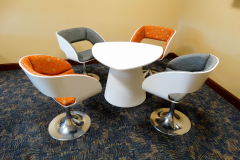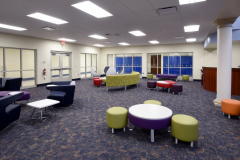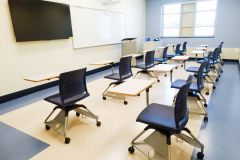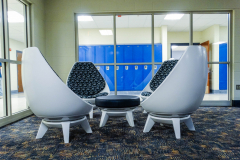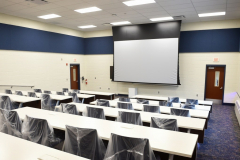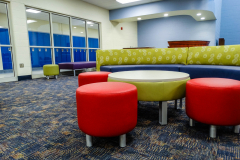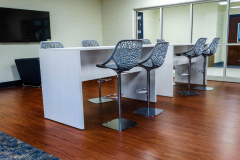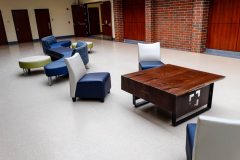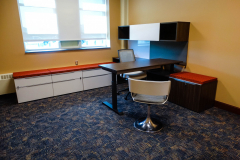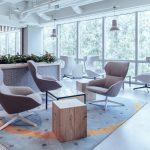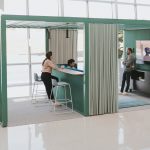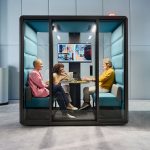Author Archives: Bellia Office Furniture
Planning for the future
Take a look around your office space. Is your space placing you at a competitive advantage not only now but for the future?
When you think of office space planning in terms of future growth, words like adjustable and flexible should come to mind. By adding flexibility into your office design, not only will you be prepared for the future, but it will maximize the efficiency of your space and add up to huge cost reduction. A recent survey stated that 51 percent of workspace is underutilized. Because this waste is rather significant, it is important to evaluate your space usage and develop a workspace solution to support long-term growth and flexibility, profitability and employee recruitment and retention.
To add flexibility into your space try to take your open office plan to the next level. Think about creating a space that allows for a combination of private offices, cubicles, collaborative areas and quiet areas too. This can be accomplished through design elements like movable walls and reconfigurable furniture, glass panels and offices to create more transparency and adding hoteling or bench seating. By incorporating these features into your space, there are two important benefits.
COST REDUCTION
For a long time, the trend was to determine space per employee, which was a fixed amount of space. As most companies have moved to an open office plan, the way space is defined has changed. No longer do your employees need (or want) a dedicated area, so the space per employee decreases dramatically leading to reduced corporate real estate costs.
EMPLOYEE SATISFACTION
According to a recent survey conducted by Gensler, by creating a work environment that allows employees to the options of collaborative and solo working areas results in a high-performance workplace where employee satisfaction increases by an average of 12 percent.
Through strategic planning and evaluation of your space, you can create a space to reflect your changing needs as a company. With these changes, employee satisfaction and productivity will increase and profitability will follow.
HEALTHCARE: Tips For Improving Clinical Design
Lets explore some tips for improving clinical design in healthcare. The nationwide shift toward outpatient (ambulatory) care continues to rise at a steep rate to meet demand. As a result, the growing prevalence of outpatient care facilities has taken on tremendous importance for today’s healthcare providers.
From 1992 to 2012, outpatient visits to community hospitals in the U.S. rose from roughly 367 million visits annually to more than 678 million visits a year. Reports state that by even the most conservative measures, the amount of money being spent on outpatient construction is expected to grow nearly 20-30 percent in the next decade.
Ultimately, the goal of more effective clinic design is to improve the quality of outpatient care and increase efficiencies among medical team members. The insights shared within this whitepaper will help the healthcare industry make more enlightened design decisions when planning a floor plan that helps reach healthcare goals.
Planning Your Legacy – Prepare For Future Innovation
Every CEO leaves a legacy behind, and while office design may not be the first thing that comes to mind when thinking of your leadership goals, it plays a valuable and important role in defining the mark you will leave as a leader.
Research shows that the key to leaving a lasting legacy of success is to prepare for future innovation. The best way to do this is by creating an optimal workspace for your employees and management to not only grow your brand, but to be highly productive and enthusiastic as they do so, and to have your space reflect your mission and values. It is also important to create an atmosphere where your employees, not only learn and advance, but genuinely feel invested in the company’s future and growth.
Look at your space through your employees eyes. Is your space a sea of cubicles that stifle inspiration and collaboration? Is technology seamlessly integrated into your office environment? Through the use of creative interior design, you can leave your company in a position for future innovation and growth.
Planning for your company’s future will also bring an immediate return to your employees. By investing in their space, you are investing in them. They will recognize that their hard work means something and that you are creating a more suitable environment to spend their time. By making sure that your workspace suits your employee’s growth needs, and your company values, you’ve taken the first step. What does your workspace say about your legacy?
Contact us today so we can match your workspace to the legacy you plan to leave behind.
Cumberland County Technical Education Center

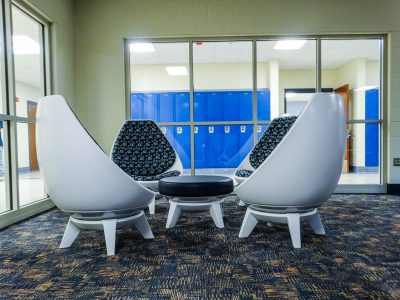 3400 College Dr, Vineland, NJ 08360
3400 College Dr, Vineland, NJ 08360
When CCTEC was approved for a full time vocational facility, they needed:
- A reliable, strategic-minded partner that would not only help to create an engaging space, but would also keep the project on track.
- To create a space that would cater to the needs of a student engaged in their education.
- To provide their students with a place that would increase their productivity.
CCTEC was able to accomplish all of those things while working with Bellia. Their students now have a comfortable, flexible facility that sky-rockets productiveness, allows them to easily work both independently and collectively, and draws in new students who want to work in such a space. The new student and faculty lounges provide a tranquil space to give your brain a break, and are thoughtful and inviting with their dining options and decor.
Collegiate Design: The New Driver for Workplace Design
When making the jump from collegiate to corporate environments, recently hired graduates are often “lost in transition.” 82% of them in fact. Not only are new hires baffled by the relevance of their physical space (“cube farms”), but also by the work styles expected of them.
In order to support the work styles of the newest workforce, collegiate design may influence the next evolution in workplace design. Corporations competing in the race for talent should borrow design and workspace planning concepts from institutions of higher education. This whitepaper from KI explains why collegiate design is the new driver for workplace design.
Reducing Your Office Footprint: Maximizing Profitability Through Efficient Space Usage
The modern day workspace is not what it used to be. Offices are no longer a maze of cubicles only because this model doesn’t work anymore. The new generation of workers desires a more open and flexible office environment, and with that, companies have started to consider ways to maximize the efficiency of their workspace.
According to Development Magazine, the average size of new leases has declined by 8 percent in the last decade. One of the causes of this decline is that employees no longer have to be tied to a workstation or cubicle to be productive and businesses have gone to an open floor plan. What was once the gold standard: 250 square feet per employee, has now changed to 185 square feet. Technology alone has ignited this change. As businesses utilize laptops, wireless technology and cloud storage, reducing office square footage is now a feasible solution that will not only protect the bottom line but offer the flexibility and openness that the new workforce desires.
As technology changes the landscape of the modern office, design trends reflect that. By using bench seating, collaborative work areas, and more shared spaces, companies have been able to maximize efficiency and minimize excess space reducing the employee cost per square foot. Allowing businesses to utilize smaller spaces while keeping their workforce the same size.
Efficient space usage through an open floor plan has many far reaching benefits. Not only will it reduce costs while increasing profitability, but it will maximize productivity, create a positive company culture through openness and flexibility, and enhance your brand. Accomplishing this alone is a monumental task, by choosing the right team of design professionals to help you through the process, not only will you see an immediate return on your investment but also reach your corporate goals. Lets discuss how we can save you on your bottom line.
Race For Talent: Communicate Company Values Through Design
Today it’s more critical than ever for organizations to attract and retain top talent, and one component that can be used for recruiting, but is often overlooked, is the workplace. It’s more than just desks and chairs. Research shows that the work environment accounts for up to 25% of job satisfaction. Offering workers an attractive package that includes fair compensation is one way to help keep workers satisfied. The next step is for organizations to invest in a well-designed workplace that communicates its commitment to company values and brand….
Tips on how the CIO can help Reduce Distractions in an Open Office
About 70 percent of US companies have adopted an open office. The benefit of having an open office is that it maximizes space while keeping down costs, since it reduces the cost per square foot of each employee. But the amount of distractions employees encounter often hurt productivity. As the CIO of the company, there are ways that you can reduce distractions through the use of technology.
TURN OFF COMPUTER SOUNDS
Computer sounds are a major source of interruption and are distracting for many employees.
NOISE CANCELLING HEADPHONES
Noise cancelling headphones have become a must-have in office accessories. By wearing noise cancelling headphones, it indicates that the employee is busy and doesn’t want to be interrupted, as well as eliminates background noises within the office.
MASK THE SOUND BY INCREASING BACKGROUND NOISE
This one may sound a little funny, increasing noise helps to eliminate it? It actually works. White noise (like a small fan running at your employees’ desks), makes conversations sound unintelligible to the listener.
WORK AT NON-PEAK TIMES
Stagger employees schedules or allow remote working capabilities. One of the best ways to work in a quiet office is to do it when most people aren’t at work. By offering a flexible work environment, employees will have the ability to stagger their schedule to reflect their needs.
QUIET ZONES
Most companies who have an open office, have incorporated areas that are quiet zones. By having the quiet area integrated to technology, it will allow for an easy transition from the desk to the quiet zone when time is of the urgency.
While there are many benefits to an open office, a recent study suggests that distractions have the potential to cause 86 minutes of lost productivity a day. Taking a few measures to eliminate distractions throughout the work day is important to achieve a productive, positive office environment.
How the CFO can help Reduce Distractions in an Open Office
About 70 percent of US companies have adopted an open office. The benefit of having an open office is that it maximizes space while keeping down costs, since it reduces the cost per square foot of each employee. But the amount of distractions employees encounter could often hurt productivity.
A recent study suggests that distractions have the potential to cause 86 minutes of lost productivity a day. So to get the most out of your employees workday, try recommending a few of these tips to eliminate distractions in your open office to achieve a productive, positive office environment.
TURN OFF COMPUTER SOUNDS
Computer sounds are a major source of interruption and are distracting for many employees.
WORK AT NON-PEAK TIMES
Stagger your employees schedules. Besides creating a quiet office, flexible schedules are also viewed as a benefit amongst employees and new hires which will help you recruit top talent as well.
NOISE CANCELLING HEADPHONES
Noise cancelling headphones have become a must-have in office accessories. By wearing noise cancelling headphones, it indicates that the employee is busy and doesn’t want to be interrupted, as well as eliminates background noises within the office.
MASK THE SOUND BY INCREASING BACKGROUND NOISE
This one may sound a little funny, increasing noise will eliminate it? It actually works. White noise (like a small fan running at your employees’ desks), makes conversations sound unintelligible to the listener.
QUIET ZONES
Most companies who have an open office, have incorporated areas that are quiet zones. This is a designated area for those that have an important task to be completed and do not want to be interrupted.
How the CEO can help Reduce Distractions in an Open Office
About 70 percent of US companies have adopted an open office. The benefit of having an open office is that it maximizes space while keeping down costs, but the amount of distractions employees encounter often hurt productivity. To get the most out of your workday, have your staff try a few of these tips to eliminate distractions in your open office floor plan.
TURN OFF COMPUTER SOUNDS
Computer sounds are a major source of interruption and are distracting for many employees.
WORK AT NON-PEAK TIMES
Stagger your employees schedules and allow remote working capabilities. Besides creating a quiet office, flexible schedules are also viewed as a benefit amongst employees and new hires which will help you recruit top talent as well.
NOISE CANCELLING HEADPHONES
Noise cancelling headphones have become a must-have in office accessories. By wearing noise cancelling headphones, it indicates that the employee is busy and doesn’t want to be interrupted, as well as eliminates background noises within the office.
MASK THE SOUND BY INCREASING BACKGROUND NOISE
This one may sound a little funny, increasing noise will eliminate it? It actually works. White noise (like a small fan running at your employees’ desks), makes conversations sound unintelligible to the listener.
QUIET ZONES
Most companies who have an open office, have incorporated areas that are quiet zones. This is a designated area for those that have an important task to be completed and do not want to be interrupted.
While there are many benefits to an open office, a recent study suggests that distractions have the potential to cause 86 minutes of lost productivity a day. Taking a few measures to eliminate distractions throughout your work day is important to achieve a productive, positive office environment.

